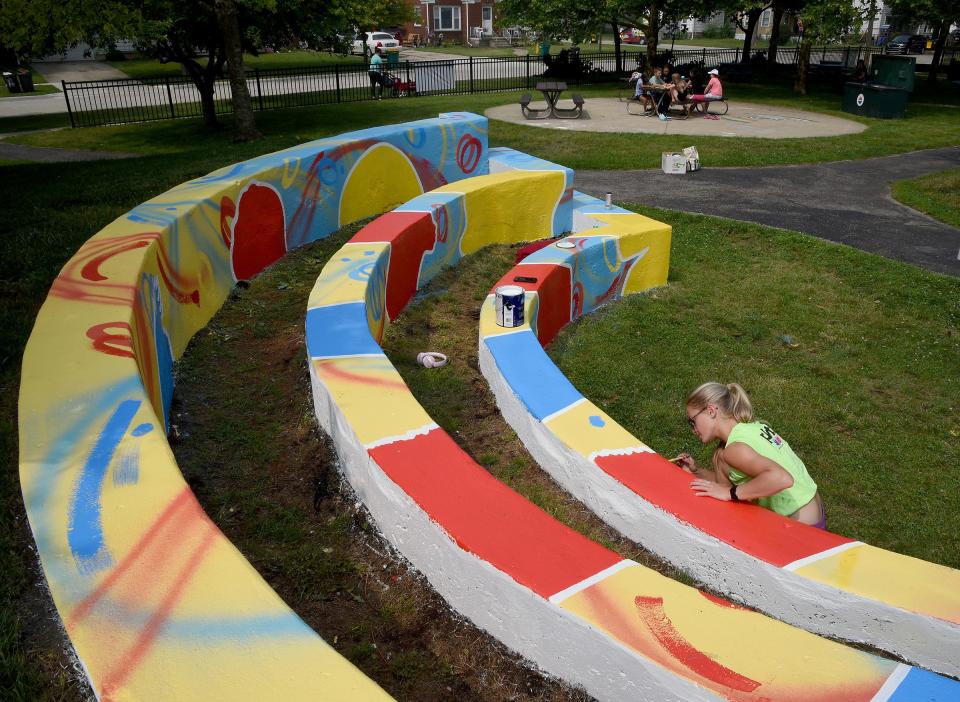Monroe City Council approves ordinance for public art installations
MONROE — Art is about free expression, but it is not necessarily a free-for-all when it comes to public art installations. However, following an ordinance approval, there is now a clearly defined process for doing so in Monroe.
In a 6-0 vote during its regular meeting Dec. 4, the Monroe City Council approved a new ordinance that defines how public art installations are to be approved and what types of projects are allowed.
Ordinance 23-004 defines what qualifies as installed public art: “Any works of art or creative artistic expression intended to be installed on, in, or as a part of public spaces, public assets, public property, or public rights-of-way or private property licensed to the city for purposes of display.”
The ordinance also includes standalone pieces such as sculptures; integrated works such as geoglyphs and mosaics created on facades, pavement or landscapes; and murals applied to building surfaces or building-mounted sculptures.

Any installed public art that is not part of a temporary special event must be approved by the Citizen’s Planning Commission on a case-by-case basis. Afterward, the property owner must submit a permit application.
Other rules in the new ordinance address topics such as depictions of real, identifiable people, alive or deceased, as well as the review process and timeline planning.
The city also maintains the right to order removal of public art installations for various reasons, including vandalism, maintenance strains, unmet deadlines and safety issues.
The city council had previously discussed the ordinance updates during meetings in June, September and November. During its Nov. 20 regular meeting, the council approved the ordinance’s first reading and scheduled a public hearing for the Dec. 4 session.
During the public hearing, no public comments were offered, and the board moved on without any council comments. However, the council and others engaged in a lengthy discussion prior to the first reading. Part of that discussion focused on whether public art installations should be governed by an ordinance or a policy.
Matthew Vanisacker, the city's deputy director of economic and community development and neighborhood services coordinator, said during the council’s Nov. 20 work session that he and others involved considered that choice before making its recommendations to council.
“On the enforcement end, it makes a little bit more sense to have it in the form of an ordinance rather than a policy,” Vanisacker said. “It reads very similar to some of our other ordinances.”
Vanisacker also noted that some of the language for the new ordinance was taken directly from an existing city ordinance that addresses blight issues.
Monroe Mayor Robert Clark thanked Vanisacker and noted that he was happy to see that the city council had been presented with a clearly worded ordinance on which to act and approve.
“Written in this fashion, it’s more reassuring,” Clark said. “It gives us a structure to work from as people are coming forward and they can understand the process.”
Subscribe Now: For all the latest local developments, breaking news and high school sports content.
Councilman Andrew Felder expressed concern that requiring a professional résumé and references might exclude amateur artists, students or collaborative groups from displaying public art in Monroe.
“I just want to be inclusive in the way that we allow for art to be done within our community,” Felder said.
City attorney Matthew Budds explained that, for example, an art teacher applying for permission to create a public art installation should be able to include some past references or cite previous art projects to prove qualifications.
“The teacher would have a résumé and could provide some sort of references for other projects they’ve been involved in,” Budds said. “I would think that would be something that would certainly be taken into account in the review process.”
Felder replied that to take that position, it means that the council would only approve installations by artists who have prior experience.
“It would (have to) be their fourth project, presuming they’ve had three other ones elsewhere,” Felder said. “It’s not an encompassing space for new people.”
City Manager David Robinson further responded by clarifying that a résumé could include something as minimal as a sixth grade art class and references could simply come from a previous teacher or a neighbor.
“I don’t think that precludes anybody,” Robinson said. “It doesn’t exclude anybody from being able to do this.”
This article originally appeared on The Monroe News: Monroe City Council approves ordinance for public art installations
